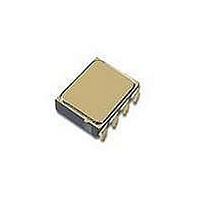HCPL-5121-100 Avago Technologies US Inc., HCPL-5121-100 Datasheet - Page 13

HCPL-5121-100
Manufacturer Part Number
HCPL-5121-100
Description
ISOLAT 1.5KVDC 1CH TOTEM 8SMD BJ
Manufacturer
Avago Technologies US Inc.
Datasheet
1.HCPL-5120.pdf
(16 pages)
Specifications of HCPL-5121-100
Output Type
Push-Pull, Totem-Pole
Package / Case
8-SMD Butt Joint
Voltage - Isolation
1500VDC
Number Of Channels
1, Unidirectional
Current - Output / Channel
2A
Propagation Delay High - Low @ If
300ns @ 10mA ~ 18mA
Current - Dc Forward (if)
25mA
Input Type
DC
Mounting Type
Surface Mount
Configuration
1 Channel
Maximum Propagation Delay Time
500 ns
Maximum Forward Diode Voltage
1.8 V
Minimum Forward Diode Voltage
1.2 V
Maximum Reverse Diode Voltage
5 V
Maximum Forward Diode Current
18 mA
Maximum Power Dissipation
295 mW
Maximum Operating Temperature
+ 125 C
Minimum Operating Temperature
- 55 C
Number Of Elements
1
Forward Voltage
1.8V
Forward Current
25mA
Package Type
PDIP
Operating Temp Range
-55C to 125C
Power Dissipation
295mW
Propagation Delay Time
500ns
Pin Count
8
Mounting
Surface Mount
Reverse Breakdown Voltage
5V
Operating Temperature Classification
Military
Lead Free Status / RoHS Status
Contains lead / RoHS non-compliant
Lead Free Status / RoHS Status
Lead free / RoHS Compliant, Contains lead / RoHS non-compliant
Figure 26. Typical Application Circuit with Negative IGBT Gate Drive
Figure 27. Energy Dissipated in the HCPL-5120 for
Each IGBT Switching Cycle
Figure 28. Optocoupler Input to Output Capacitance
Model for Unshielded Optocouplers.
3
CONTROL
INPUT
P
I
V
Duty Cycle
P
I
V
V
E
f
1
2
3
4
F
CC
SW
E
F
O
CC
EE
7
6
5
4
3
2
1
0
Parameter
Parameter
(Rg, Qg)
0
+5 V
C
C
74XXX
OPEN
COLLECTOR
LEDN
LEDP
20
Rg - GATE RESISTANCE - Ω
270 Ω
40
Description
LED Current
LED On Voltage
Maximum LED
Duty Cycle
Description
Supply Current
Positive Supply Voltage
Negative Supply Voltage
Energy Dissipation in the HCPL-5120 for each
IGBT Switching Cycle (See Figure 27)
Switching Frequency
60
Qg = 100 nC
Qg = 250 nC
Qg = 500 nC
V
V
CC
EE
= 19 V
= -9 V
1
2
3
4
80
8
7
6
5
100
8
7
6
5
0.1 µF
LED Drive Circuit Considerations for Ultra High CMR Perfor-
mance.
Without a detector shield, the dominant cause of op-
tocoupler CMR failure is capacitive coupling from the
input side of the optocoupler, through the package, to
the detector IC as shown in Figure 28. The HCPL-520
improves CMR performance by using a detector IC with
an optically transparent Faraday shield, which diverts
the capacitively coupled current away from the sensitive
IC circuitry. However, this shield does not eliminate the
capacitive coupling between the LED and optocoupler
pins 5-8 as shown in Figure 29. This capacitive coupling
causes perturbations in the LED current during common
mode transients and becomes the major source of CMR
failures for a shielded optocoupler. The main design ob-
jective of a high CMR LED drive circuit becomes keeping
the LED in the proper state (on or off ) during common
mode transients. For example, the recommended ap-
plication circuit (Figure 25), can achieve 0 kV/µs CMR
while minimizing component complexity. Techniques
to keep the LED in the proper state are discussed in the
next two sections.
Figure 29. Optocoupler Input to Output Capacitance
Model for Shielded Optocouplers.
+
_
+
_
1
2
3
4
V
V
CC
EE
Rg
C
C
= 15 V
= -5 V
LEDN
LEDP
C
SHIELD
Q1
Q2
LEDO1
C
LEDO2
8
7
6
5
3-PHASE
+ HVDC
- HVDC
AC














